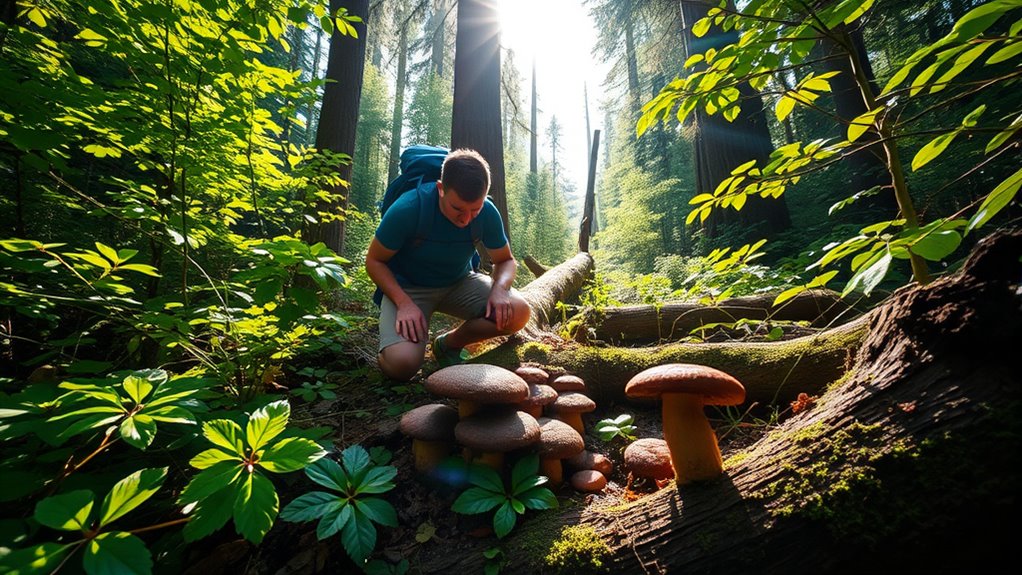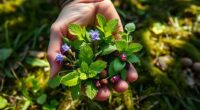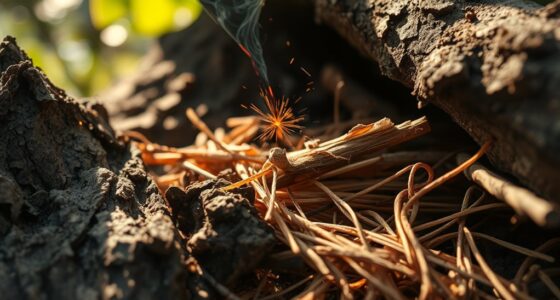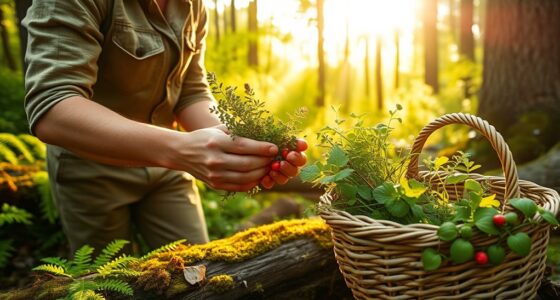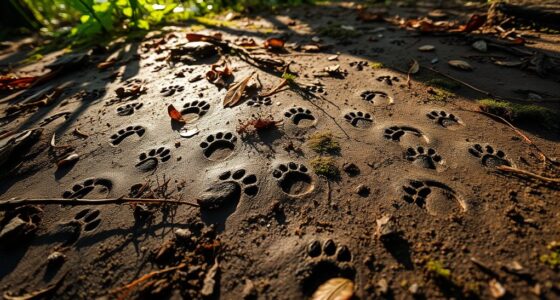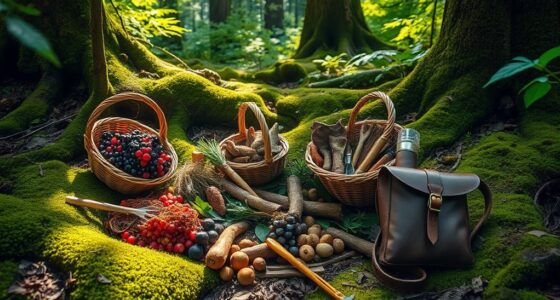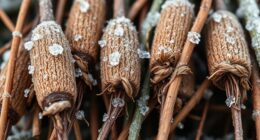In wilderness survival, foraging for food involves correctly identifying safe, edible plants, berries, insects, and other natural resources. Focus on key features like leaf shape, flower structure, and habitat, and use tools or guides to avoid poisonous look-alikes. Harvest sustainably, respecting nature, and prepare your finds properly to stay healthy. Learning seasonal variations and water sources helps guarantee a reliable food supply. Keep exploring, and you’ll discover more ways to confidently gather wild nourishment.
Key Takeaways
- Identify edible wild plants using key features like leaf shape, flower, and habitat, avoiding toxic species such as poison ivy or nightshade.
- Harvest only sustainable amounts, respecting property rights and local regulations, to conserve plant populations and ecosystems.
- Collect and prepare wild fruits, roots, and insects properly—e.g., cooking insects thoroughly and processing roots—to ensure safety and nutrition.
- Use tools, field guides, and apps for accurate plant identification and water sources, while applying water purification methods like boiling.
- Recognize seasonal variations and environmental cues to find reliable food sources and adapt foraging strategies accordingly.
Understanding the Basics of Edible Wild Plants
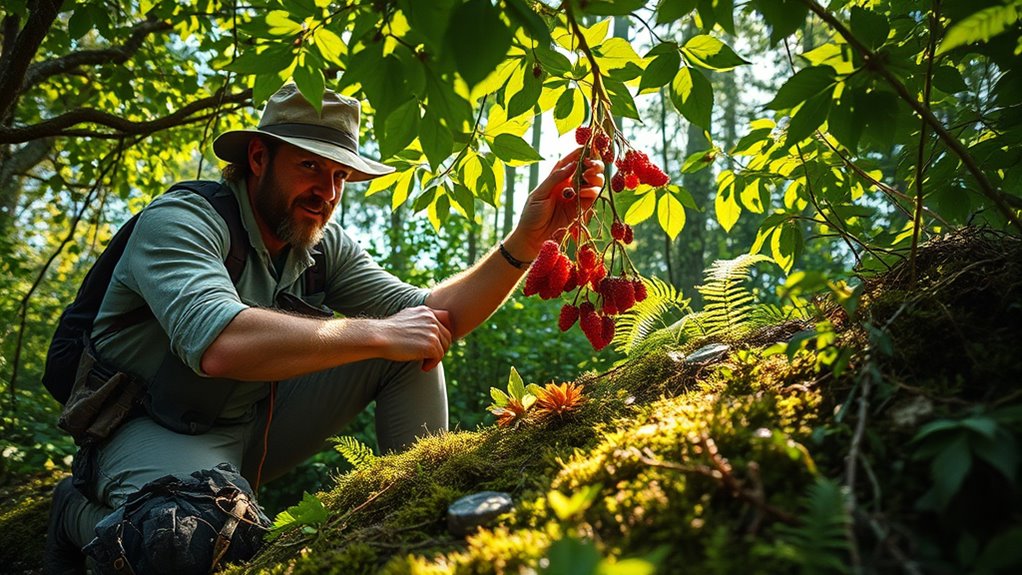
To safely identify edible wild plants, you need to understand their key characteristics and how they differ from poisonous lookalikes. Focus on leaf shape, which can be lance-shaped, needle-like, or broad and flat, and note how leaves are arranged—alternately, oppositely, or in whorls on the stem. Pay close attention to flowers, fruits, and seeds, as these reveal important clues about a plant’s edibility. Examine the stem’s structure, including its thickness, color, and texture, since these features aid identification. Also, consider the plant’s habitat; many edible species grow in specific environments, helping narrow down your options. Recognizing these traits ensures you correctly identify safe plants and avoid dangerous lookalikes in the wild. Additionally, understanding plant identification techniques can enhance your ability to distinguish safe, edible species from toxic ones, especially when visual cues are subtle. Developing skills in wild food foraging can further improve your confidence and accuracy in the field, making your foraging safer and more successful. Being aware of emotional responses in your surroundings can also help you stay alert and observant while foraging, ensuring your safety in unfamiliar terrain. Paying attention to plant scent can provide additional clues, as many edible plants have distinctive aromas that set them apart from toxic lookalikes. Recognizing these traits ensures you correctly identify safe plants and avoid dangerous lookalikes in the wild. Additionally, understanding dream symbols can enhance your awareness of subconscious cues that might influence your perception of nature and survival scenarios.
Recognizing Common Survival Edibles in Nature
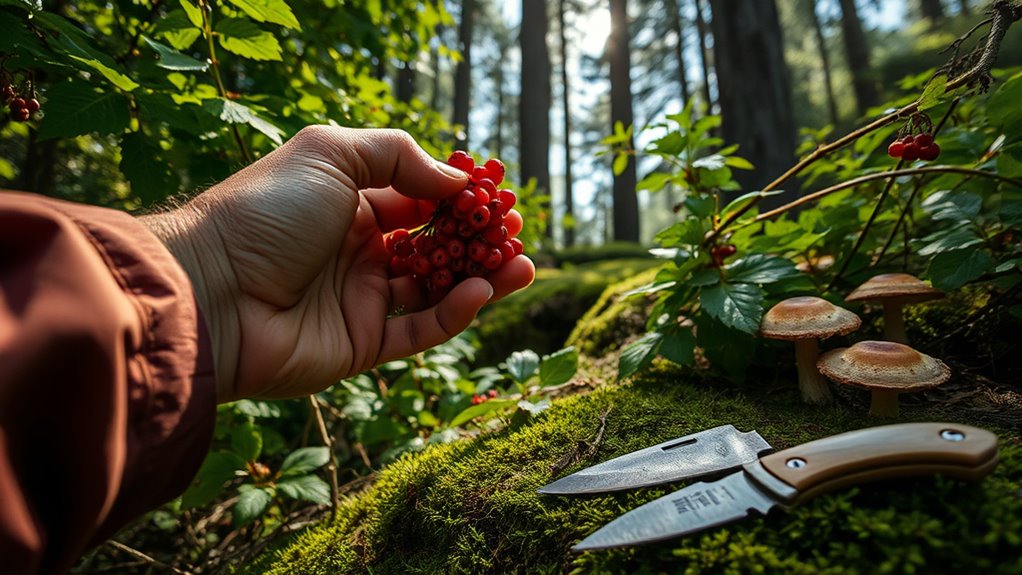
Recognizing common survival edibles in nature is essential for ensuring your safety and nutrition when you’re stranded or foraging in the wild. Familiarize yourself with plants like prickly pear cactus, which offers edible fruit after removing spines, and dandelions, found almost everywhere, with edible leaves and flowers. Thistles provide roots and leaves, best harvested in early summer or fall. Cattails are vital, offering roots and shoots rich in nutrients. Grasses yield seeds and young shoots that are safe to eat. In various regions, burdock roots, wild banana fruits, bamboo shoots, and acorns are valuable resources—though some require processing. Recognizing these plants’ edible parts, such as leaves, fruits, roots, stems, and seeds, helps you identify safe, nutritious options in the wild. Additionally, understanding how to identify safe plants involves recognizing fetal development indicators, which can be useful for ensuring your safety during life-threatening situations. Being aware of safe plant identification techniques can significantly improve your chances of survival.
Keys to Proper Plant Identification and Safety

Proper plant identification is crucial for safe foraging in the wild, especially since many edible plants have poisonous look-alikes. To identify plants accurately, use techniques like Newcomb’s Method, examining flower shape, leaf type, and plant structure. Pay close attention to leaf characteristics such as shape, veins, and color, and observe flower features, stem type, and plant growth stage. Regional knowledge is essential—familiarize yourself with local flora and consult multiple guides or apps to cross-reference findings. Use your senses—sight, smell, and touch—to gather clues. Always be cautious of poisonous plants like poison ivy or nightshade. Never consume a plant unless you’re absolutely sure of its safety, as misidentification can be deadly. Additionally, understanding the importance of proper plant care and maintenance can help ensure your foraged plants remain safe and nutritious. Proper plant identification techniques are vital for distinguishing between edible and harmful species. Incorporating up-to-date safety guidelines from reputable sources can further reduce risks while foraging. Continuous learning, including awareness of local edible plants, and careful observation are your best tools for safe foraging. Developing a systematic approach to plant identification methods can greatly improve your accuracy and confidence in wild foraging.
Seasonal Variations in Wild Food Availability
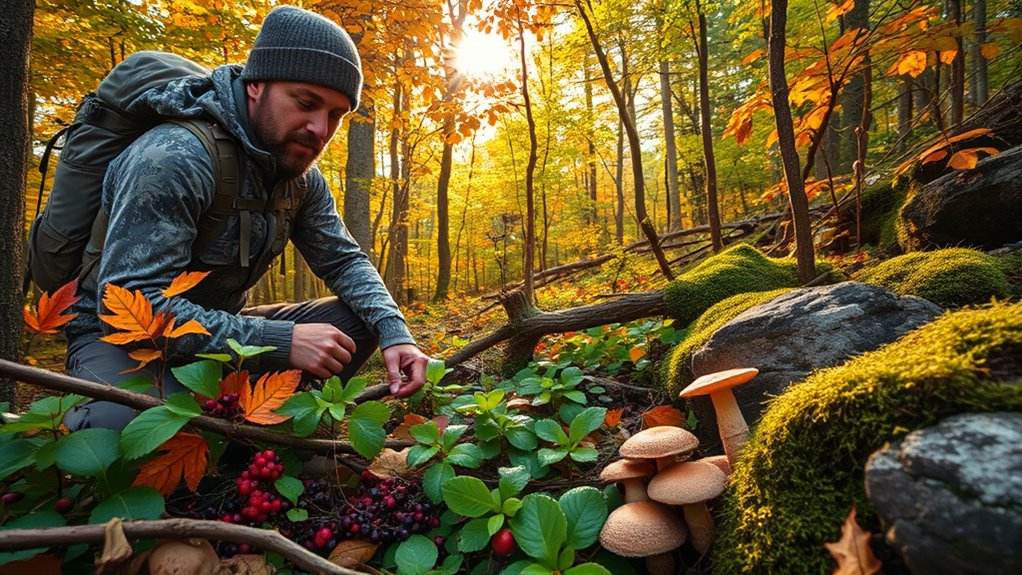
Wild food availability shifts throughout the year, influenced by seasonal changes in climate and environment. You’ll notice that in different regions, resources vary dramatically.
Wild food sources change with the seasons, varying greatly across different regions worldwide.
In Alaska, for example, a diverse range of foods like salmon, land and marine mammals, birds, shellfish, and wild plants support resilience during seasonal fluctuations. Understanding shark behavior can also help foragers avoid dangerous encounters when sourcing seafood in coastal areas. Additionally, local knowledge about seasonal patterns is essential for successful foraging and safety. Recognizing plant cycles can further enhance your ability to gather edible wild plants at their nutritional peak, ensuring a more sustainable and effective foraging experience. Being familiar with native ecosystems can help identify the most reliable food sources throughout the year. Moreover, awareness of cookie categories and their purposes can guide foragers in understanding how external factors may influence resource availability and safety considerations.
In tropical areas, fruits peak during rainy seasons, while flowers bloom more during dry seasons. Climate change further affects predictability, making some foods harder to find. Communities adapt by diversifying their harvests, storing foods like dried berries or frozen fish for leaner times.
Your foraging efforts should consider these patterns, focusing on what’s abundant during each season and adjusting your strategies accordingly to maximize your wild food intake.
Ethical and Responsible Foraging Practices
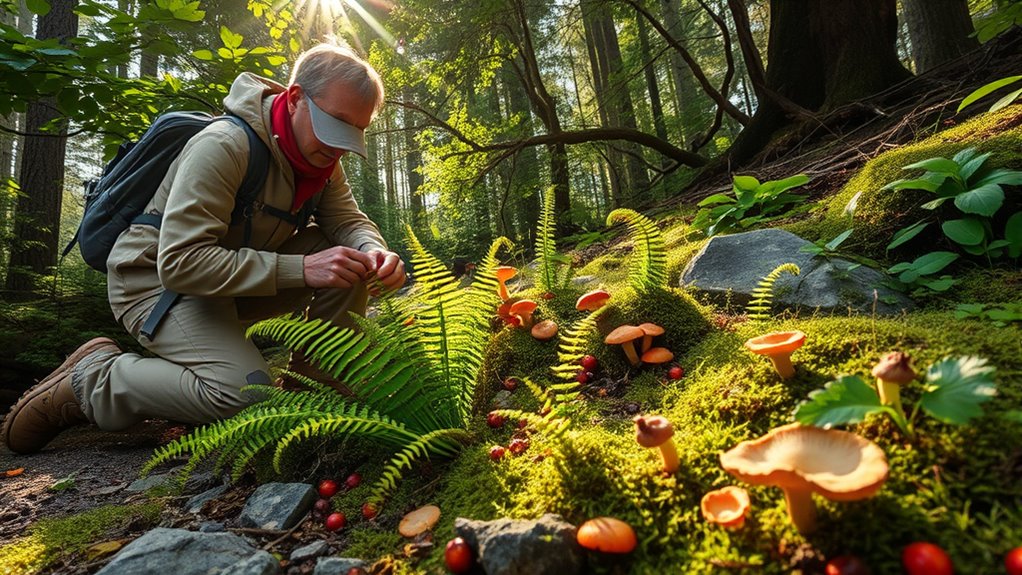
Ethical and responsible foraging is essential to guarantee that our harvesting practices support the health of ecosystems and the sustainability of wild food sources. You should always seek landowner permission before foraging on private property and clearly recognize property boundaries.
Avoid taking endangered or rare species to help conserve biodiversity. Harvest only what you need, leaving enough for plants to reproduce and ensuring future availability. Practicing self-awareness can help you better understand your environmental impact and improve sustainable practices.
Being mindful of the ecological impact and human activity helps ensure that foraging remains sustainable and beneficial for future generations. Minimize disturbance to habitats, steer clear of polluted areas, and follow local regulations. Additionally, understanding local plant populations can aid in identifying sustainable harvesting zones and times. Recognizing the importance of seasonal variations can further support responsible foraging practices. Be mindful of the ecological impact and adapt your harvesting methods seasonally.
Respect cultural sites and avoid disrupting natural habitats or life cycles. By raising awareness and collaborating with communities and experts, you help promote sustainable foraging that benefits both ecosystems and future foragers. Incorporating best practices can further enhance your contribution to conservation efforts.
Utilizing Tools and Resources for Accurate Identification
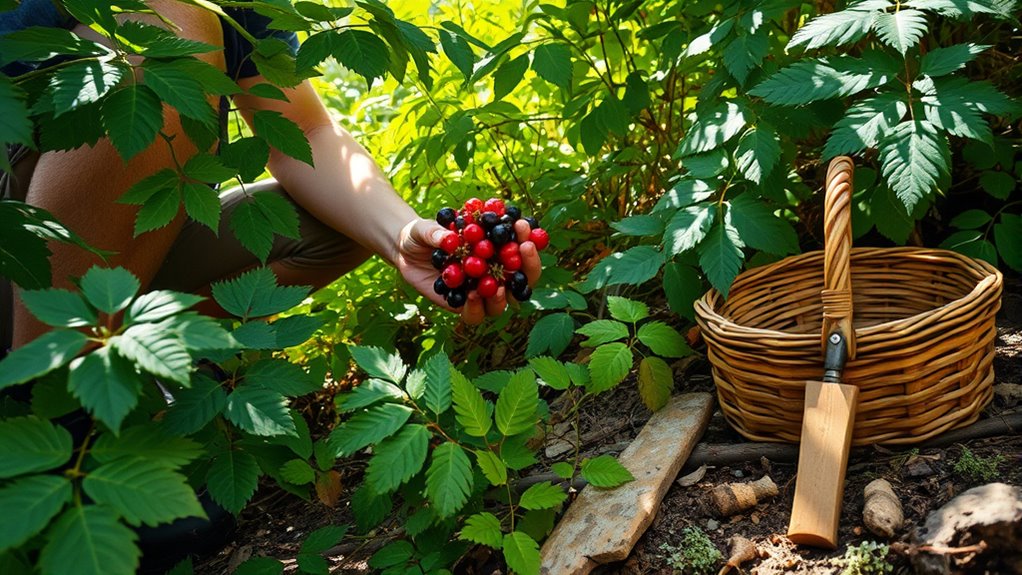
Utilizing the right tools and resources is essential for accurately identifying edible plants in the wild. Field guides are invaluable, offering detailed descriptions of plants, including look-alikes and poisonous varieties. Mobile apps like PlantSnap can provide quick identification, especially when you’re unsure about a plant’s appearance. Design thinking principles can help you develop a systematic approach to recognizing patterns and solving problems during your foraging adventure. Specialized books deepen your understanding of plant uses and hazards, while online forums connect you with experienced foragers who can offer advice. Local experts, such as botanists, can give region-specific insights that enhance your knowledge. Carrying essential tools like pruning shears, digging implements, gloves, and containers helps you handle plants safely and efficiently. Additionally, understanding payment processing concepts like secure online transactions can be useful when researching or purchasing identification tools and resources. Learning about sustainable harvesting practices ensures you forage responsibly without harming the environment. Recognizing the importance of environmental monitoring can help you identify safe foraging sites and avoid areas with pollution. Incorporating air quality indicators and monitoring environmental conditions can also help you assess the safety of foraging areas, reducing exposure to pollutants. Combining these resources ensures you recognize edible plants correctly, minimizing risks and maximizing your foraging success.
Gathering and Preparing Wild Berries and Fruits

After correctly identifying edible plants, the next step is to gather and prepare wild berries and fruits safely. Look for elderberries, recognized by their purple clusters, and harvest them when ripe. Blackcurrants are easy to spot by their round, black appearance, while dewberries trail on the ground similar to blackberries.
Gooseberries and mulberries are also common; mulberries ripen from mid-spring to early summer. Always double-check your identifications with a trusted guide to avoid toxic berries like yew or holly. Establishing healthy boundaries during foraging, such as respecting plant growth and not overharvesting, helps maintain the environment’s balance.
Once gathered, berries can be used to make jams, jellies, or dried for later use. Freezing preserves their nutrients, and drying can enhance medicinal properties. Properly preparing wild berries ensures you maximize their nutritional and practical benefits safely in your wilderness survival plan.
Foraging for Insects and Other Protein Sources
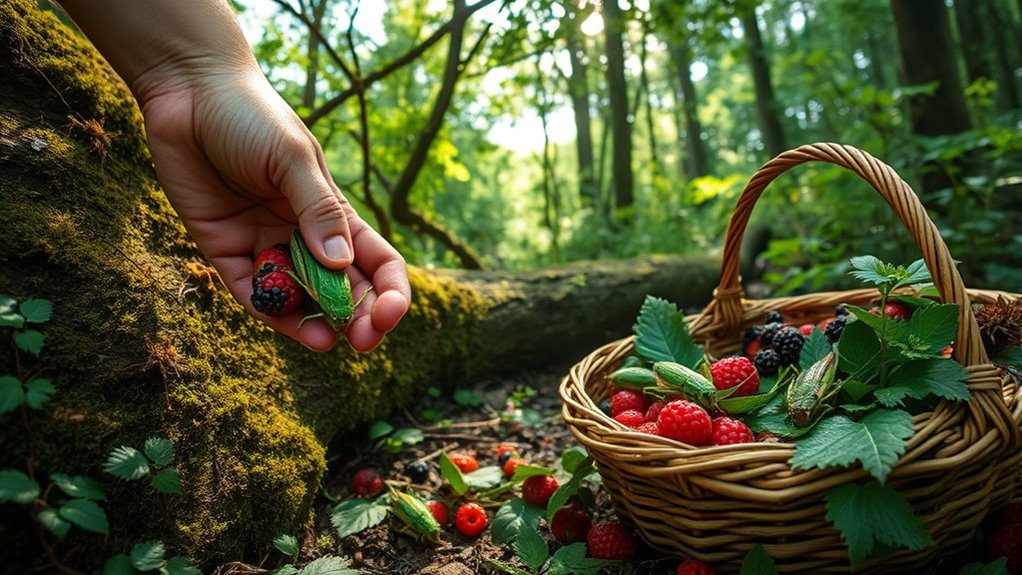
When foraging for protein in the wild, insects like grasshoppers, ants, earthworms, and crickets offer a reliable and nutrient-dense food source.
To stay safe, learn how to identify edible insects and avoid toxic or allergenic species such as wasps or bees.
Proper preparation, like roasting or cooking, reduces the risk of foodborne illness.
Insects are rich in protein and contain essential nutrients like iron and zinc, making them a valuable survival resource.
You can also farm crickets easily, providing a sustainable protein source in captivity.
Always guarantee insects are thoroughly cooked, and be cautious of species-specific dangers.
Incorporating insects into your diet can help sustain you when other food sources are scarce, offering a crucial boost in survival situations.
Prioritizing Water and Hydration Strategies
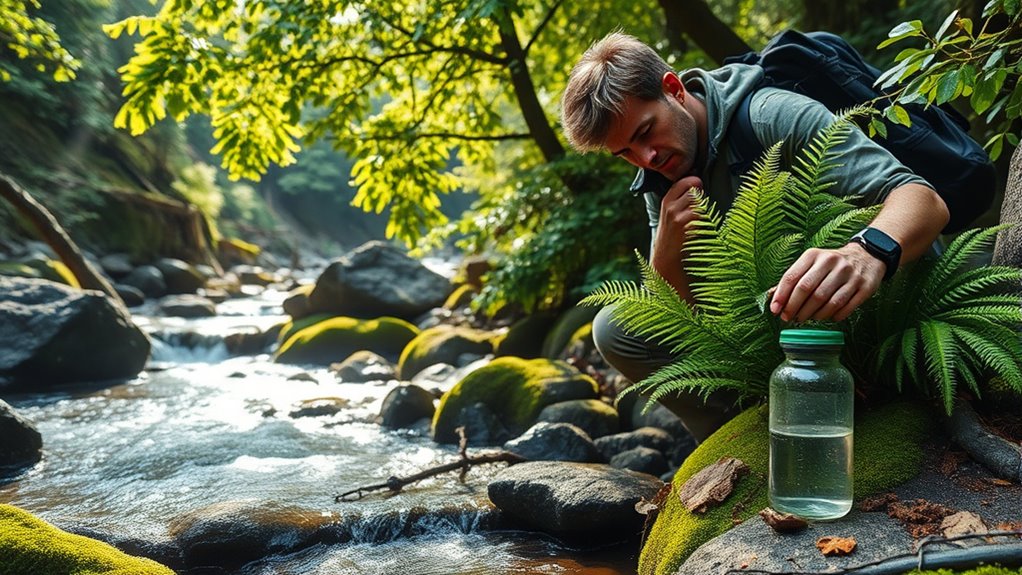
Prioritizing water and hydration is essential for survival, especially in harsh environments where water sources may be scarce. Look for streams, rivers, and lakes, which are reliable sources, and watch for water flowing over rocks, indicating filtration that reduces contaminants.
Collect rainwater with tarps or large leaves, and gather morning dew for small amounts of water. Animal tracks leading to watering holes and lush vegetation can also guide you to water.
Always purify your water with boiling, solar disinfection, ceramic filters, or chemical treatments. Drink small, frequent sips to stay hydrated, and use electrolyte tablets or consume foods rich in essential minerals.
Conserve water by limiting unnecessary use, collecting rainwater, and minimizing hygiene activities to ensure your supplies last longer.
Developing an Adaptive Foraging Approach in the Wild
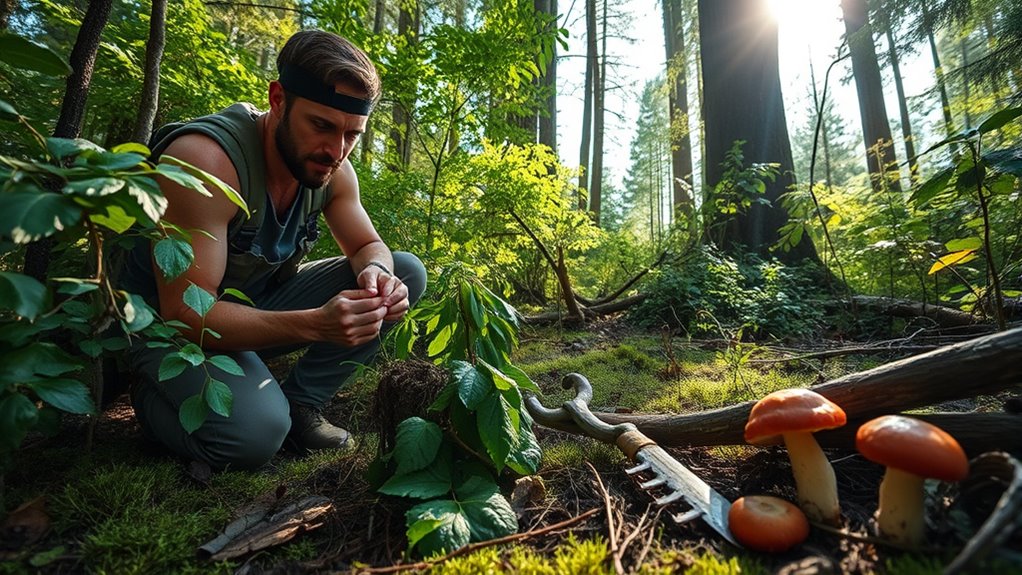
Developing an adaptive foraging approach in the wild requires you to tailor your strategies to the specific environment you’re in. Start by understanding local ecosystems—identify edible plants like cattails, acorns, and stinging nettles, and note seasonal changes that affect their availability.
Recognize regional differences and environmental indicators, such as animal activity or condensation, to guide your efforts. Adapt your techniques whether in a jungle, forest, or wetlands, adjusting for climate and terrain.
Use nearby water sources to find aquatic foods and landmarks to remember foraging spots. Incorporate traditional knowledge from indigenous practices, respecting cultural significance and sustainable harvesting.
Always identify poisonous plants, watch for allergies, and practice safe, responsible foraging to maximize your chances of success and preserve the environment.
Frequently Asked Questions
How Can I Identify Edible Plants Safely Without Prior Experience?
To identify edible plants safely without prior experience, start by researching and consulting local experts or field guides.
Observe plants over different seasons and look for key traits like leaf texture, flower shape, and sap.
Avoid plants with milky sap, fine hairs, or umbrella-shaped flowers, which often indicate toxicity.
Always test cautiously using the universal edibility method, and never eat anything unless you’re completely sure it’s safe.
What Are the Most Common Poisonous Plants to Avoid While Foraging?
Oh, so you’re ready to play “Poisonous Plant Detective”? Well, avoid those sneaky look-alikes like poison ivy, poison oak, and giant hogweed—they’ll turn your outdoor adventure into a fiery rash or blister fest.
Steer clear of water hemlock and poison hemlock, as they resemble safe greens but are deadly. Remember, if it’s toxic parts or resembles edibles, it’s probably best left untouched.
Play it safe, and enjoy nature responsibly!
How Do Seasonal Changes Affect the Availability of Wild Foods?
Seasonal changes directly impact the availability of wild foods, so you’ll notice more options in spring and summer, while winter often limits your choices.
As animals migrate or prepare for hibernation, their food sources shift, affecting what you can forage.
Plant life cycles also fluctuate, making wild plant foods more abundant during certain seasons.
Adapting your foraging habits to these changes guarantees you gather the most available and nutritious foods year-round.
What Are Sustainable Harvesting Practices to Protect Wild Plant Populations?
Imagine a lush, vibrant forest teeming with diverse plants. To safeguard these wild populations, you should assess plant abundance, choosing widespread species over rare ones.
Rotate harvest sites, avoid pollution, and always seek permission. Educate yourself on at-risk plants, monitor seasonal changes, and involve local communities.
These sustainable practices help maintain healthy ecosystems, support livelihoods, and ensure that future generations can enjoy nature’s bounty without depleting it.
Which Tools or Apps Are Best for Identifying Plants in the Field?
You want to know the best tools for identifying plants in the field. Use apps like PlantSnap for quick AI-based recognition, iNaturalist for community verification, and PictureThis for detailed guides and toxicity alerts.
Always take clear photos, and consider regional apps tailored to your location. Pair these with physical field guides and local knowledge for the most accurate identifications.
Practice regularly to sharpen your plant identification skills.
Conclusion
Remember, mastering wild foraging can increase your survival chances markedly—studies show that foraging skills can provide up to 60% of your nutritional needs in a pinch. Always respect nature and follow ethical practices to guarantee sustainable harvesting. By staying informed about seasonal changes and plant safety, you’ll become more confident in identifying edible species. With these skills, you’ll not only survive but thrive in the wilderness, turning nature’s bounty into your greatest resource.

